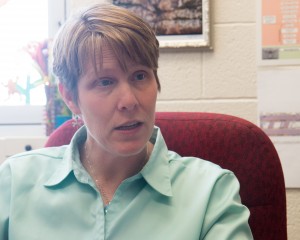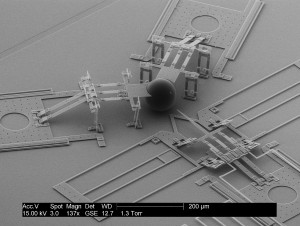
BYU’s ‘nanoinjector’ project is a groundbreaking development for gene therapy research. The American Institute of Physics published BYU researchers’ findings in its journal, the Review of Scientific Instruments, on May 13.
Nanoinjection allows researchers to insert DNA from one species into the cell of another. Once the DNA is inside the cell, researchers hope the cell will begin to express the injected DNA’s characteristics. The technique can be used to treat Alzheimer’s, diabetes and cancer.
BYU’s departments of biology and mechanical engineering work together to increase the method’s effectiveness. Historically, nanoinjection treated one embryonic cell at a time, but current advancements have allowed 4 million adult cells to be treated at a time.
“It was really exciting to have the very first cell expressing the first gene that we put in,” said Sandra Burnett, of BYU’s biology department. “It’s not just in our heads as being a good idea, but it’s something that’s actually functional.”
The project is fundamentally a biological endeavor, but the equipment necessary to achieve results requires mechanical expertise. Undergraduate, master’s and Ph.D. students, as well as faculty from the departments of biology and mechanical engineering, have their hands in the project.
“This is really exciting for the students to be involved in because they make a difference,” Burnett said. “They come up with ideas, and we try what we can. They’re actually seeing this firsthand as research progresses.”

Nanoinjection builds on the concept of microinjection, which has the same goal of inserting DNA into cells; but nanoinjection causes significantly less damage. The nanoinjector is a tiny lance hooked up to an electrical current. It’s given a positive charge to attract negatively charged DNA, which sticks to the end and sides of the lance. The lance punctures the cell wall, the positive charge is reversed and the DNA drops inside.
Microinjection, on the other hand, injects DNA into a cell with a microscopic, hollow needle. The needle, even at its smallest, causes damage to the cell, resulting in a high fatality rate. Smaller needles can be made, but as DNA travels from one end of the needle to the cell it will bounce up against the walls, breaking it apart. The nanoinjector’s lance is 10 times smaller than a microinjector’s needle.
Larry L. Howell, of the mechanical engineering department, applies creative ideas from BYU’s Compliant Mechanisms Research to the nanoinjection project. The lance and its parts are cut out from a flat microchip and then popped out to form a 3D shape.
“Origami has been doing it for thousands of years,” said John Sessions, a Ph.D. student from Clinton, Utah. “Dr. Howell and a bunch of his collaborators realized, ‘Hey, we can use it for more complex purposes.’”
Sessions is concurrently pursuing a Ph.D. in mechanical engineering and a medical degree from Midwestern University in Arizona. He makes a perfect fit for the project with his expertise in both the medicinal and mechanical aspects. Sessions took leave from his education in Arizona to return to BYU to work on the project.
“It’s very untraditional to stop medical school in the middle, but because it was such a cool opportunity, I just couldn’t pass it up,” Sessions said.
Both departments rely heavily on each other to succeed. Tyler Lewis, of Las Vegas, is pursuing his master’s degree in mechanical engineering and has contributed to the latest advancements of the project.
It’s really interesting working on an interdisciplinary team because we’re trying to work on things that we as mechanical engineers don’t fully understand, but the microbiology people do, and vice versa,” Lewis said. “You really have to have teamwork.”
Brad Hanks, a mechanical engineering major from Albuquerque, New Mexico, is one of the few undergraduates involved with the project. He’s been working on it since January 2013. He has tested the effects of different types of lances, whether blunt or sharp, and also of coating the nanoinjector microchip with silicon to improve its electrical environment.
“It gives me something more exciting than just school,” Hanks said. “I think it helps me to see where I can go with my education, how I can apply my education. I think it makes school more interesting.”
The nanoinjector has been preceded by years of research, and while it has made great strides, it will continue to advance in effectiveness and to include more applications.




